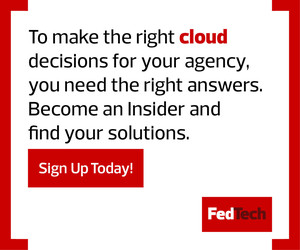FEDTECH: In your first two years at OPM, you stood up a cloud center of excellence and a cloud data center. What's next for OPM on its cloud journey?
Cavallo: It was important for us to have a home in the cloud to be able to move things to. So, by establishing the CCOE — to help educate our business partners and our OCIO staff, and then to have the cloud ready — we now don’t have to automatically default to on-premises. In fact, the default is cloud, unless I grant an exception.
We started moving more of our new applications to the cloud at the end of the last fiscal year. I'll give you a good example: Every agency has to have a Freedom of Information Act tracking system. We have a legacy system on-premises. Instead of migrating that, we bought a cloud version of it.
What we’re working on now is prioritizing all of the OPM systems, and we’ve done what we call an application rationalization review of how difficult an application is to migrate to the cloud. Does it need to be totally rewritten? Can it be moved as-is? Based on resources and funding, our end goal is to move as much of OPM's applications and data to the cloud and get out of the on-premises data center.
EXAMINE: How federal agencies can leverage cloud for application modernization.
FEDTECH: How long did that rationalization effort take? And now that it's done, how long will it take to migrate everything you can to the cloud?
Cavallo: The rationalization is actually a playbook from the Federal CIO Council, so it's available to all agencies. We modified it a bit because we wanted to put a level of difficulty with it, where the rationalization really is.
You come up with a quad chart; if you have an application that’s seen little use, the best thing for you to do is turn it off and accomplish that business elsewhere. The other three quadrants are lift and shift, modernize the platform and move the platform or do a rewrite.
It probably took us about eight months to go through and prioritize our systems. And then, the second phase of it, that we’ve been doing since November, is using agents on every single one of our servers to measure its performance, its requirements and how much data it’s using.
We now have an accurate cost estimate of what that application would cost us in the cloud.
EXPLORE: How to choose the right backup when your agency functions in multiple environments.
My business users may fear the cloud is going to be so much more expensive, or somebody's going to hit a button, and suddenly we’re going to get a million-dollar bill the next day. What my team is doing now is to provide the cost of the current on-premises data center, including factoring in a hardware refresh every three to five years, because I’ve seen a tendency for some to leave out the required cycle of hardware refresh costs when conducting this comparison. With those costs clearly identified, we are now documenting what the maximum cost would be to be in the cloud.
Right now, we’re compiling and evaluating that data. We are using consumption agents to evaluate our current traffic and usage to our applications. The longer you run that agent, the better your data is, because OPM does some very cyclical things, such as performance reviews. USA Performance is very heavily used in September and October of every fiscal year, and then the rest of the year, it sees much lower use. So, it's an ideal candidate to consider using the elasticity of the cloud. The beauty of that is, by running this agent for several months, we’re making sure that we’re capturing data from many of those peaks.
I announced in October that we wanted to hit a two-year sprint to the cloud. We’re already four months into that sprint, and we cover it every month with the team to make sure that we’re all going in that direction. Will we get everything moved to the cloud in two years? It's a lot to ask, but we are sure going to try based on our funding level. It’s definitely the stretch goal that I’ve given my team.
FEDTECH: You have a customer experience vision for opm.gov that everything will be accessible in two clicks. How will you make that a reality?
Cavallo: The executive order on customer experience was right in line with where we were already headed. The current opm.gov website is set up by department, not by user persona. We’re going to move to four common user personas.
I’m a federal employee, and I want to look up things about my benefits, pay raises, those type of things. I’m a citizen who wants to apply for federal jobs. What does that mean? How do I go about doing it? How do I find out what those benefits are? The agency HR offices that we support need to know current OPM policies. Our retirees are the other persona. They have different needs than a current federal employee, so we want to provide them a streamlined and enhanced retiree experience. By having those personas, versus clicking on a department, it’s going to make it much easier for end users to follow their journey map.
Once I know I’m looking for a federal job and click on that, that’ll take me to a page with steps that I need to do. That second click could take them right into USAJOBS. Today, they’d have to hunt around our various links, click on the HR office, click on other offices until they found what they were looking for. There’s going to be a radically different and much better customer experience when we rebuild the site.
FIND OUT: How government initiatives are driving digital transformation.
FEDTECH: Another thing you’ve done is stand up a digital services team. What IT modernization projects is the team focused on?
Cavallo: The model of introducing digital services started with 18F and the General Services Administration. What agencies like the Department of Homeland Security saw was that this is a good model, so I should incorporate it in my own organization instead of having to bring another agency in. So, I did that here.
Our digital services team has jumped on several critical things. One was the new U.S. Postal Service health benefits system. My DS team has been a big help in determining the requirements. Other things that they’ve helped on are retirement services, improving the customer experience for our retirees, and even projects like electronic signatures.
By having a separate team focused upon understanding and improving the user experience, we can then focus on modernizing our legacy systems. That’s where our digital services team best fits in. I’m able to assign them to a specific modernization project for a month or two and then have them move on to something else. That’s been very beneficial, to have them here, and they’ve made a big impact already.
DIVE DEEPER: Three factors to consider when optimizing a multicloud environment.
FEDTECH: With that health benefits example, how big was your team, and what was that process like?
Cavallo: I have a target of 10 total people, and we’re up to seven at this point. When we finally got the clear definition of what the USPS health benefits system would need, I knew that I had to assign resources right away to help identify all of the requirements of this new system. Most of those team members were customer experience and business analysts. Those were exactly the type of skills that I needed to work across our program offices to discover what all those requirements were so that we could put them into a competitive RFP, which will be released very shortly. Luckily, I already had them on board, so I didn’t have to wait to hire them, because we needed to jump on that right away.
I’m also going to end up with some permanent digital services people on USPS, along with the separate digital services team. Some of them will probably stay on USPS, and then I’ll backfill their positions with more generalists.
We need to resolve how to digitize casework at OPM, and those type of projects are where I’m looking at the digital services team bringing in a fresh view with the latest experience in technology to solve it. In some cases, I’m even asking them to set up a specific, full-time digital services team to work with one of our program offices because there’s so much work to do with them.
Initially, the idea was that we’ll bring them on board and see where they fit in. Well, demand exceeded the capacity very quickly. My plan is that we’re going to keep hiring and expand that team over time.
CHECK OUT: Read these seven tips for cloud migration.
FEDTECH: I’m going to give you an opportunity for a shameless plug here. You say you have seven people on this team. Are you currently hiring for those last three positions?
Cavallo: Yes. Last year, we brought in 16 interns and ended up hiring some of them. I’m always looking for people that are looking for a challenging environment and want to go through this legacy-to-the-cloud conversion effort. So, yes, we are actively hiring across the board, and I’m looking for the best and brightest at any age, any experience. We have plenty of opportunities for them here, and they should go to USAJOBS, because all of my hiring will be done through the OPM toolset.











